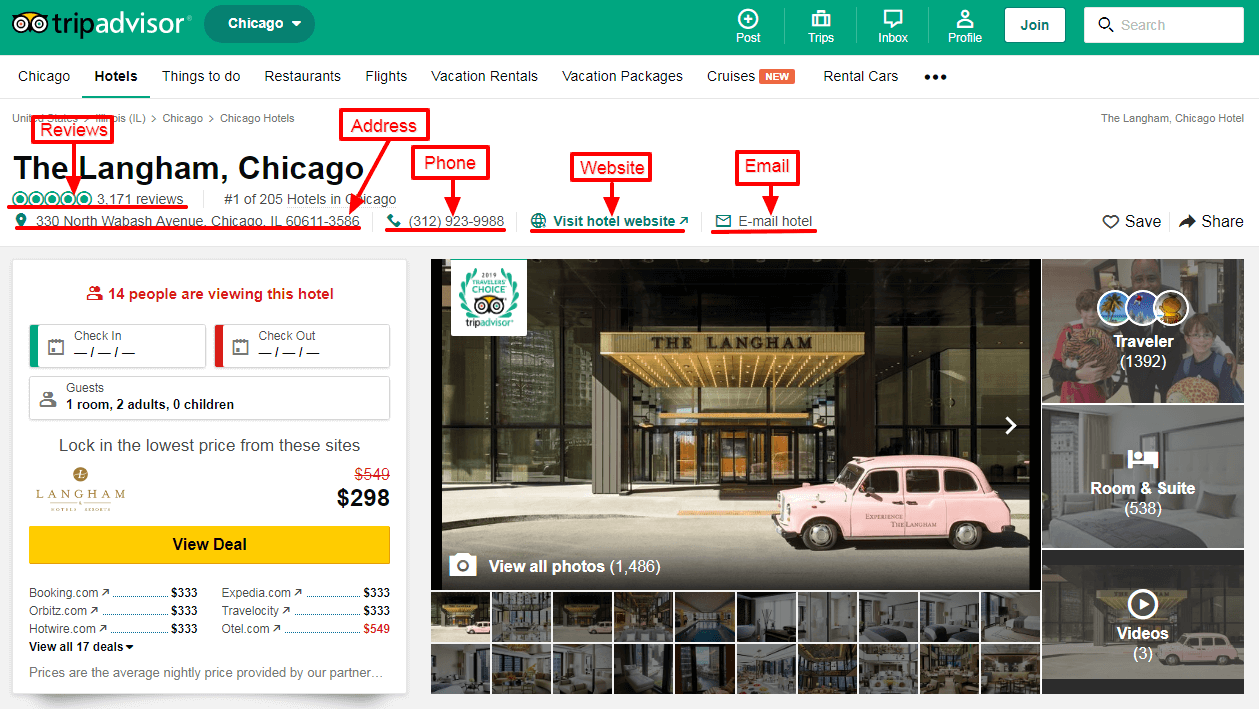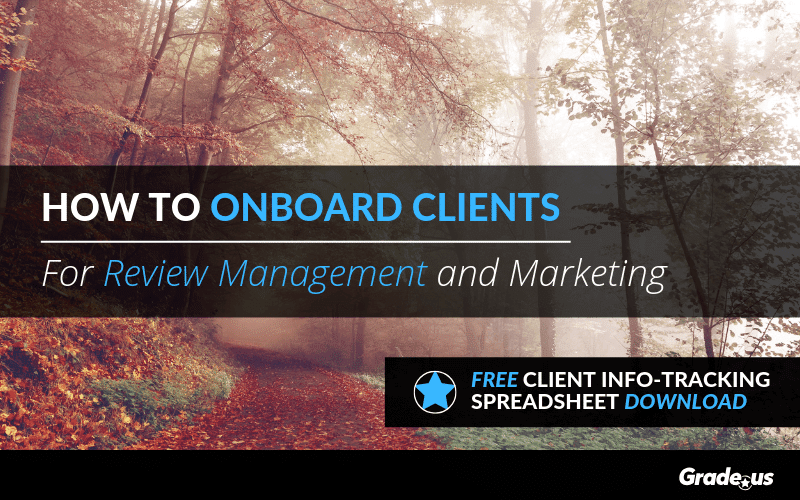Updated: 9/10/19 with plenty of new examples and templates.
You'll find a spreadsheet template for tracking your client’s business info, citations and review site listings at the end of this post. Available as an Excel or Google Docs template.
Optimizing a new client's review site listings is a lot like cleaning out a messy garage, but it's an essential first step in review management. When you onboard clients, you're collecting and organizing their crucial information.
You'll find a bunch of junk mixed in with important misplaced items. Your job is to sort through the mess, to identify what is what; keeping the good, while tossing the bad.
Incorrect citations and empty review site listings damage your prospect’s online visibility. The larger your client’s business, the more difficult it can be to unravel and uncover all of the business’s mentions.
To fix incongruities and start proactively building your client’s online reputation, you need to follow a process to properly onboard your new client and organize all of their up-to-date information.
When working with a new client you need:
- A process for onboarding your client
- An onboarding questionnaire that asks the right questions.
- A spreadsheet to track their business information, citations, and review site listings.
Know the Basics: Citations vs. Review Site Listings
Whether your agency is providing Local SEO or Review Management services, you’ll need to tackle both the company’s existing citations and their review site listings, but what’s the difference?
Citations – Find them, Fix them, Track them, Build them
"A citation is an online reference to your business’s name, address and phone number (NAP). Like links to your website, Google uses them when evaluating the online authority of your business."
It’s really as simple as a name, address, and phone number as seen in this TripAdvisor citation for the Langham hotel:

Since the internet is a pretty big place, finding your client’s existing citations, and making sure they’re correctly updated, can be like trying to find broken needles in the world’s biggest haystack. When the client has multiple brands, locations, and phone numbers, the task becomes exponentially more complicated.
Joy Hawkins, Google My Business Product Expert, and owner of Sterling Sky provides some insights for working with clients on cleaning up their citations:
"I would advise the agency to have a good, solid questionnaire that asks clients things like if they moved in the last ten years or if they have multiple phone numbers.
However, agencies should still be looking for other variations and not trusting that the client actually knows all the different things that exist online. Often clients don’t even realize they have tracking phone numbers."
As you find or create your client's citations, make sure you are tracking them through your software or on a [spreadsheet].
Some experts feel citations aren't worth the trouble since they don't produce a whole lot of ranking value. If you're working with sophisticated clients, you may experience some pushback when you bring the topic up.
You'll want to be ready with data when your clients ask.
According to Moz's 2018 Local Search Ranking Factors, citations are still a top 5 ranking factor for both the local pack and organic rankings.
But the important component here is customer perception.
How do customers feel about businesses with missing, inaccurate, or poor citation data?
Here's some data from the 2018 Local Citations Trust Report:
- 93% of consumers say they are frustrated by incorrect information in online directories
- In the last 12 months, 71% of consumers had a negative experience because of incorrect local business information found online
- Upon finding an inaccurate listing, consumers are more likely to blame the local business than the directory
This isn't all about rankings.
It's about the financial impact missing, inaccurate or incomplete citation data have on your client's business. These simple (and common) mistakes decrease website conversions, and it reduces the effectiveness of their reviews.

Think about that for a moment.
Your clients invest the time, money and resources needed to build a strong review portfolio. Working with you, they create compelling social proof that establishes your client's local business as the best choice. Their customers attempt to visit your client but are directed to the wrong address.
If we're using the data above, 40% of these customers will stop looking for your client. 68% will stop using your client's business. The financial impact here is cause for concern.
Review Site Listings
Review site listings, like Yelp or TripAdvisor, offer a discovery opportunity for customers to answer many of the questions that their prospective customers have.
First, claim your client’s review site listings.
You’d be surprised how many small businesses let their customers beat them to the punch, by claiming their listing before the company. Take ownership!
Pro-tip:
The task of claiming websites is something you need to coordinate with your client. Some review sites, like Yelp, will call the business to verify the claim. Your client needs to be available to confirm.Start tracking the listings in your spreadsheet. If your agency doesn’t have a spreadsheet in place, we have you covered (there’s a free spreadsheet template to download at the end of this post).
Once the listings have been claimed, you and your client can dive into fully filling out the profile.
Here are just some of the business attributes you can include on Yelp:

Here’s a list of both general and industry-specific company attributes for you to determine:
General Information
- Business Name(s)
- Business Phone Number(s)
- Business Location(s)
- Website URL(s)
- Brand Assets
- Brand Style Sheet (if one exists)
- Logo
- Color Palette
- Fonts
- Photos of Business
- Marketing Materials
- Social Media Channels/URL
- Etc.
- Mission Statement
- Established Date
- Number of Employees
- Primary Business Category
- Secondary Categories
- Company History
- Targeted Keywords
- Long description of company (With Keywords)
- Short description of company (With Keywords)
- Hours of Operation
- Holiday Hours
- Directions to the Business
- Products and Services Offered
- Payment Options
- Languages Spoken
Industry Specific Information
- Business Amenities (For restaurant and other service industries)
- Parking
- Pet Friendly
- Reservations Accepted
- Smoking/No-Smoking Policies
- Wifi Availability
- Hotel Specific Amenities (accommodations)
- Restaurant Specific Amenities (menu)
- Fitness (classes)
- Licenses and Accreditations (For Legal or home service companies, etc)
Working with Clients on Review Site Management
When you send your client the initial questionnaire, don’t assume all of the information they’re providing is correct. You will need to do additional research on your own.
Especially for items like primary and secondary categories, James Watt, reminds us to remember that you’re the expert:
"Don’t take the client’s word on primary + secondary categories. Categories are important for ranking well, and it’s worth the time in my view to do some competitive research.
What categories are successful companies in the major cities using? Your city?
I use competition to guide choices here pretty heavily, and it might even be that a client’s ‘primary category’ is ultimately worth putting in second place in favor of something that’ll get them a little extra exposure. There are, of course, categories the client might not have even mentioned. I usually need to do this industry research on my own anyway before I can have an intelligent conversation with the client about what they might have forgotten to tell me in this area."
It’s essential for the client to understand that if anything changes about the business, not only does it need to be updated on the website (especially NAP items), but each of the review site listings need to include the new info as well.
For instance, when educating the client, James suggests that you, "make sure you establish that any hours of operation changes need to be communicated to you beforehand so that they can be reflected on the website and (at least) their profile on Google. Make sure the client understands the value of updating holiday hours, or just hour changes in general, quickly, so they can feed you the right info at the right time."
An Inside Look Into How an Agency Operates
Efficiently organizing your client’s information and having the right onboarding processes in place is key to providing the best service.
Justin Bilyj, Director of Local SEO of BantaMedia, was kind enough to give us a peek into how his agency operates:
"We take a three-phased approach to building our internal client folder to help manage the flow of information without getting bogged down."
We recommend every agency establish a clear set of guidelines for every phase of service, like a roadmap for where the project is headed. Our three-phased client process is:
Phase one: Introduction. During this phase, we present the client with our Executive Proposal, if they agree to move forward, we go over standard operating contract.
Phase two: Discovery and Execution. We start by interviewing the client about the ins and outs of their business. By collecting all the info we’ll need upfront, it helps the process go more smoothly later on. We are finding out:
Brand fonts, colors, and logos
Existing brand standards (including licensing documentation or legal disclaimers)
Social media channels they are currently using
Business name, addresses, phone numbers and operating hours
The brand’s background story and “About Us” boilerplate text
Keywords and hashtags relevant to the company
Differentiating brand messages they are currently marketing on their channels
From that initial discovery meeting, we create three mandatory documents: a brand profile, a master login list of directory listings, and an outreach list of bloggers, media outlets, and key influencers relevant to their business.
I can’t tell you how often during a project, we reference this brand profile, because it keeps all the pertinent info about a client, beyond their citations, right at our fingertips. Every agency should develop some type of one-page master “brand standards” document to quickly convey content creation and posting guidelines for each client’s citations or local SEO work. (This is also the same brand profile we use for clients that work with us for content creation or social media management.)
Depending on the types of services the client hired us for, there may be additional supplementary files like:
Website Audit
Citation Audit
Competitor Analysis
Backlink Profile
Local Linking Questionnaire (Phil Rozek has a great one)
Content Strategy
Editorial Calendar (for content creation and social media posting)
Having a master spreadsheet that lists every citation should be mandatory for Local SEO agencies. We use an Excel spreadsheet for ours. After the client’s Google My Business page has been verified (which is the first task on our checklist), we use their Google-verified business listing to begin a citation audit by making sure every listing matches the information on Google – which is the chief citation, in our opinion.
A citation audit is a key step because it gives you a complete picture of the client’s local online presence before you start adding any citations. Within the audit, we check every major review site and niche directory – updating our master login list as we go so we have a listing of these in one place. Our citation audit lists each website URL, any account login info provided by the business owner or created by us, and notes about any updates we make to fix incorrect citations.
We keep all the client’s brand logos, images, videos, and other assets in the same folder next to the Brand Profile for easy access when creating or updating citations.
Review management campaigns are a bit of a paradox. In most cases, 30 days isn't enough time to deliver truly game-changing results. But that's exactly what clients, regardless of their experience, want.
Here's a 30-day review management plan you can follow to do just that.

The majority of this work will be front loaded for your client's campaign. You'll want to transition your client's campaign to a 90 plan that's focused on delivering big wins. It takes time to produce these wins for your clients but the 30-day plan, if executed properly, will provide you with the client goodwill you need to continue.
Here's your focus with the 90-day review management plan.

Since we're focused on onboarding clients, you'll want to make sure they're prepared for the scenarios you'll face during their campaign. These issues include:
- No reviews, no systems or procedures
- Some reviews, no systems
- Bad reviews/reputation no systems
- Great reviews, lopsided portfolio
- Some reviews, lopsided portfolio
- Bad reviews, lopsided portfolio
The majority of your clients will fit into one of these scenarios. You'll run into the occasional client who seems to have their ducks in a row. Great reviews, a balanced review portfolio and the systems and procedures they need already in place.
You can help these clients as well.
Simply focus your attention on two areas:
1. Retaining the progress they've already made
2. Gaining ground with more reviews, more listings and citations
This is ideal because it means that you're able to help any client, regardless of their situation or circumstance. If they're looking for a way to improve their business and they're the right client for your agency, you can deliver value on their behalf.
"Phase three: Advanced Reporting, or I.D.E.A.
The last part of our process is Execution and Advanced Reporting. Depending on the service, there’s a variety of metrics that we measure and put into monthly reports for the client to review, and we discuss this in a monthly status report call.
Here's a starter set of metrics you can track.
- Users per channel (i.e., this might include GMB traffic, review site traffic, social media traffic, local website referral traffic, etc.)
- Users by citations and listings
- Sales by channel (enhanced eCommerce)
- Leads by channel
- Website bounce rate
- Forms filled
- Call tracking metrics
- Funnel conversions and drop-offs
- Video views
- Scroll depth
- Session duration
- Event sign-ups
- Pages per session
- Appointments scheduled
- Paid ad conversions
- Conversion rates
When it comes to reporting, you'll want to feel your clients out.
Clients are easily overwhelmed. Follow their pace and watch for signs they're glazing over, lost or confused. Evaluate your client's level of sophistication. Ask them questions and listen to their responses. How they respond is just as important as what they say.
If your client uses technical or jargon-heavy language to describe their campaigns or data, you know you're dealing with an "in-the-know client." If they use generic language or they don't understand the question, you're dealing with a beginner who will appreciate you dumbing things down. Other clients want to be perceived as equal. Speak as you normally would, but leave small breadcrumbs of data they can use to rise to the challenge.
Be gentle, gracious and patient.
Speak to their level of experience. Understand that your clients aren't as knowledgeable as you are. That's why they've hired you, that's a good thing.
It’s shocking that any agency would offer services like these without offering at least an hour on the phone with the client every month; it’s just good customer service. Addressing questions and providing recommendations on this call can even be a great client retention tool. You’re not just doing mysterious work in the background at that point; you’re actually paying attention to the client and really personalizing your service.
It’s easy to accumulate a vast number of citations across the web
Review site listings demand updates when changes are made to your client’s business. By having all of your client’s information organized in a spreadsheet, your agency’s task of cleaning up and updating these online mentions will be more efficient and comprehensive.
Put an onboarding process in place to best serve your clients. They’ll appreciate your systematic efforts as they begin to see their online visibility improve and new customers walk through their doors.
About the Author
Garrett Sussman
Garrett is the Head of Marketing at Grade.us, an online review management and marketing platform. When he's not crafting content, he's scouting the perfect ice coffee, devouring the newest graphic novels, and concocting a new recipe in the kitchen.









